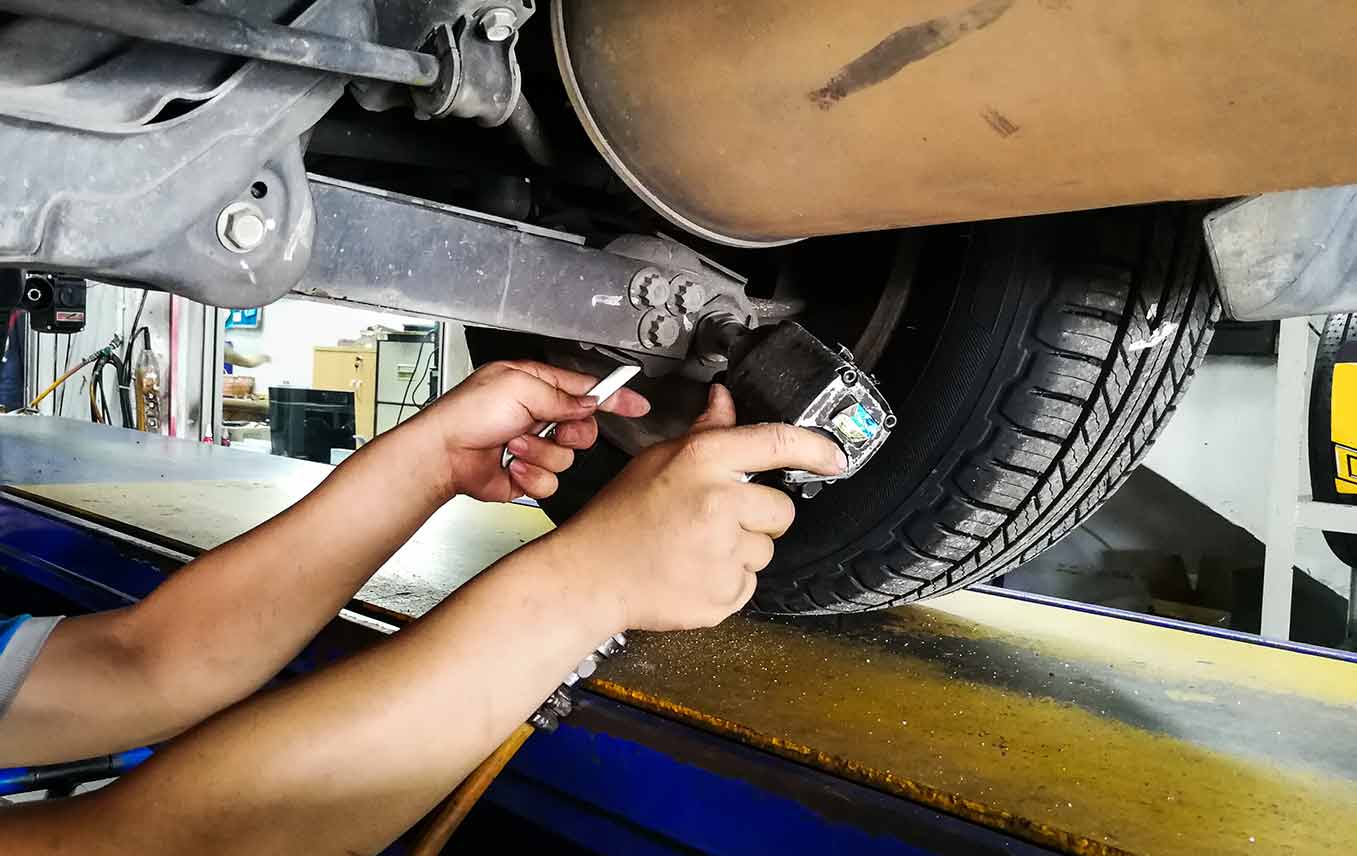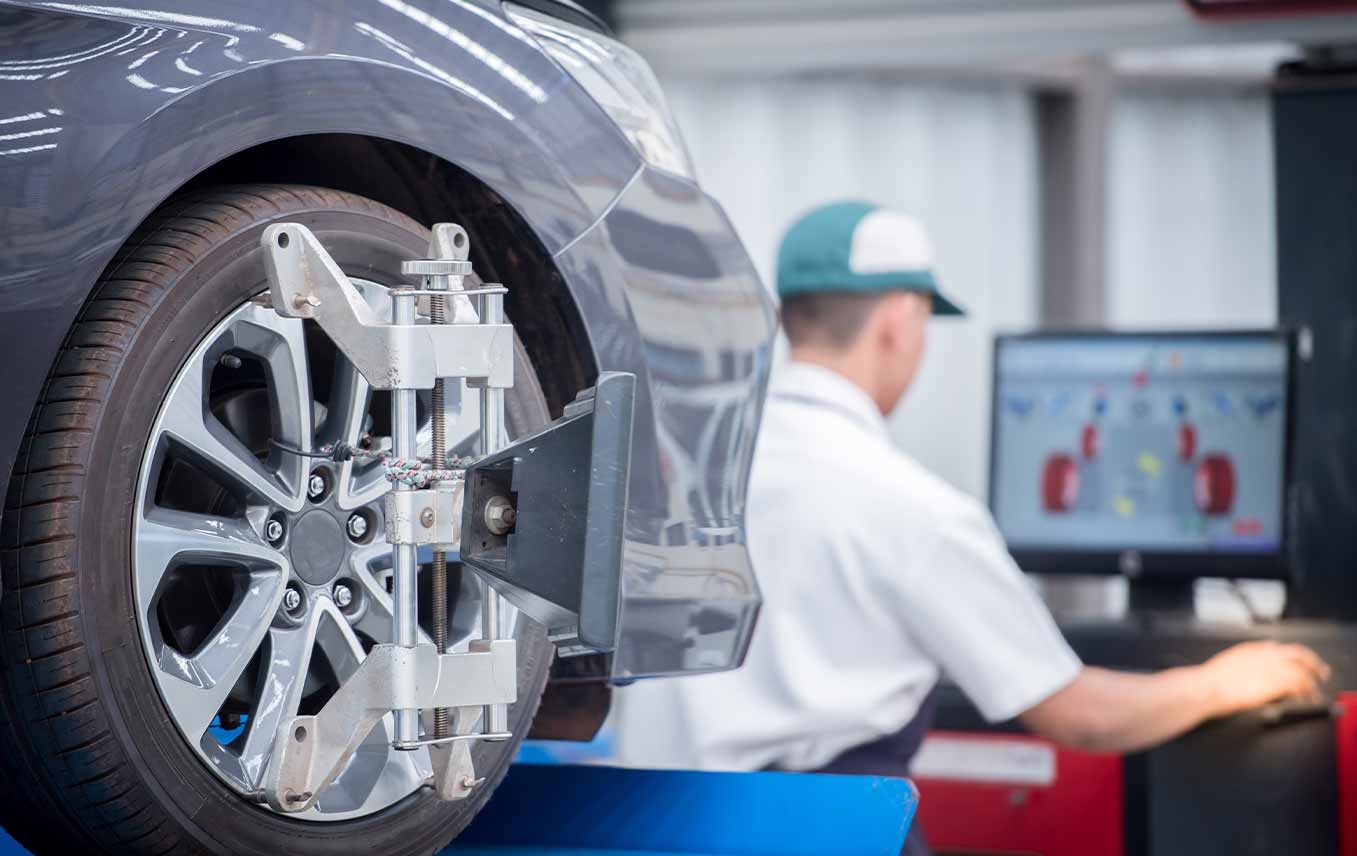A wheel alignment might not seem like that big of a deal since, unlike many other mechanical issues, you can still drive your car even if your alignment is a little off. People will often put off getting an alignment to save money, but it can end up costing you down the road. An improper wheel alignment will cause excess tire wear and can lead to the breakdown of other steering components. Not to mention the fact that it can be dangerous for you and others on the road to drive your car in that condition. If you want to know more about the importance of an alignment and how much is a wheel alignment, then keep reading!
How Much Does a Wheel Alignment Cost?
One of your first thoughts might be, “How much does an alignment cost?” To fully understand the cost of a wheel alignment, let’s first discuss exactly what is involved in the job. When your car first rolls off the assembly line, the wheels should all be aligned and set to factory specs. This means that the two front wheels sit perfectly square with each other and also perfect square to the rear wheels. In addition, the steering wheel is completely centered when the wheels are aimed straight ahead.
Over time, your car becomes out of alignment. Hitting bumps and potholes in the road, banging against a curb, or running over debris in the roadway can cause your wheels to move from their perfect positions. When this happens, they can begin to work against each other instead of all working in perfect harmony. They need to press a reset button to get things back to normal again – this reset button is the wheel alignment job.
Years ago, mechanics would spend a great deal of time taking measurements and adjusting each wheel as necessary to put things back in perfect alignment. There are many measurements that go into an alignment. The most common are as follows:
- Caster
Caster refers to the front to back measurement of your wheel or as it sits in relation to the steering arm. If the wheel is too far forward or backward, it can lead to problems – especially if the wheel on the opposite side of the car is in a different position.
- Camber
Camber refers to the side to side position, or the lean, of your wheel when looking at it from the front or back. If the wheel is leaning too far to one side or the other, then you’ll start to get excess tire wear on the inside or outside of the tire. The wheel should be perfectly level from a vertical standpoint.
- Toe In/Toe Out
Toe in and toe out refer to the position of the wheel when looking down on it from the top. The wheel should be pointed directly straight ahead and not turned to one side or the other. In some cases, a slight toe in or toe out may be necessary, but generally, the wheels should point directly straight.
In the old days, a front-end alignment was typically performed where the mechanic would measure each of these angles and positions to ensure that things were properly aligned with the two front wheels. Today, things are actually much easier.
Most modern cars now require four-wheel alignments. However, mechanics no longer need to measure and make these adjustments manually. Today, special tools are used that quickly calculate all the measurements and tell the mechanic exactly what to adjust. In addition, adjustments are made to all four wheels and not just the front two. This helps ensure the best possible alignment and handling.
Many people ask, “How long does an alignment take?” It usually takes a mechanic about an hour to perform a proper alignment, assuming that no major problems are encountered during the job. You can expect to pay somewhere between $75 to $150 for a tire alignment at your local ASE-certified automotive repair shop. Some high-end vehicles like Mercedes and others will run you more than this. You might pay up to $500 to have an alignment performed on these vehicles because of the special tools required and precise manufacturer’s specifications that must be met.
While this is not extremely expensive compared to some other repairs, if you’ve let your bad alignment get too far, then you might need to replace suspension parts as well. You could be looking at replacing tires, ball joints, steering arms, struts, or other parts. Now your pricing is into the thousands because of the additional required repairs. Ball joint replacement costs or wheel bearing replacement expenses can really add to your expense! In that case, you’re probably better off just selling that old car to Auto Wranglers. We’ll make you an instant cash offer to purchase your vehicle and tow it away for free – even with a bad alignment!
How Do You Know When You Need a Wheel Alignment?

There are many symptoms of a bad alignment, and you should be able to tell pretty easily when it’s time for an alignment. Most of them don’t require much mechanical knowledge either, so even if you have no mechanical ability, you can tell when your car needs an alignment.
One of the first, and easiest to spot, signs of misalignment is excess, uneven, or premature tire wear. If you notice that your tires are wearing on one side faster than the other, then it’s time for an alignment. If you notice ridges in your tires, like the front of the tread is wearing faster than the back, or vice versa – alignment time! With a proper wheel alignment, all four tires should wear at approximately the same rate and evenly across the tires.
Another obvious sign of problems is when your steering wheel begins to pull to one side. If you are driving down the highway and let go of the wheel momentarily, your car should continue straight ahead mostly on its own. If your car pulls to one side or the other, then it’s likely that you have car alignment problems that need to be fixed.
Poor fuel economy can also point to a bad alignment. If your car is not aligned properly, then it does not travel down the road as easily as it should. Your tires should rotate nice and smoothly, working in unison, as your car travels down the road. When they become out of alignment, they can start to work against each other and require more power to travel down the road. This leads to decreased fuel efficiency and hits your wallet as you have to buy more gas. If you notice your gas mileage has started to decrease, then maybe you should inspect your vehicle for proper alignment.
If you aren’t quite sure whether you need an alignment, most auto repair shops will provide a free alignment check to determine whether you have any issues. It doesn’t take them long to perform the check. Even most tire shops have certified technicians that can perform wheel alignment services. They simply put your car on the alignment rack and let the computer do its work. They can tell you in just a few minutes whether you need to have your car’s alignment adjusted. Unfortunately, an alignment is not generally covered under your car’s warranty unless it was caused by a faulty part.
What Are The Benefits of a Wheel Alignment?
Proper wheel alignment has many benefits – not the least of which is helping you keep money in your pocket! A proper alignment can help improve fuel economy and extend the life of your tires. New tires are expensive, so making them last as long as possible can save you quite a bit of money! The benefits you get will greatly outweigh the tire alignment cost.
In addition to saving you money, a proper wheel alignment also makes your car easier to drive and makes it safer for you, your passengers, and others on the road. A car that is misaligned can be dangerous to drive as it can suddenly pull to one side or have a blowout due to excess tire wear. Your stopping distance can also be increased due to a bad alignment, and you might need to end up replacing your brake pads sooner than necessary.
How Often Should You Get a Wheel Alignment?
There is no hard and fast rule on how often you should have your car aligned. If you notice any of the symptoms that we’ve mentioned, then you should definitely have it done. On the contrary, you likely don’t need to have it done as often as an oil change. Most mechanics agree that it’s a good idea to check your alignment every 6,000 – 10,000 miles.
Some repair shops even offer a lifetime warranty on their alignment services. It will cost you a little more up front, but you can bring your car in at regular intervals to have an alignment performed at no additional cost. Most people will go ahead and perform tire balancing at the same time, as balancing and alignment often go hand in hand.
Your driving conditions can also play a role in how often you should have an alignment performed. If you drive off-road or on extremely bumpy roads often, then you will have to get alignments more frequently. If you only drive your car on the weekends on perfectly smooth pavement, then you can likely go a couple of years without the need for an alignment.
Conclusion
Wheel alignments are a fairly inexpensive maintenance item that you should not take for granted. Left unattended, a misalignment can lead to bigger and more expensive problems. Problems with your alignment are usually easy to spot, so do not ignore the warning signs! Get your car down to your mechanic so that they can perform the alignment quickly and easily – this is not a job you want to attempt yourself without the proper tools and equipment. If you decide you don’t want to sink any additional money into your old car, then give Auto Wranglers a call. We buy cars throughout the country, and we’ll make you an instant cash offer on yours so that you can buy a new car.


